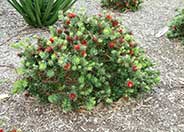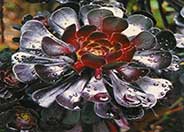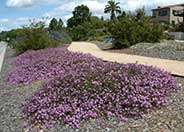
Common name:Purple Hopseed Bush or Hop Bush
Botanical name:Dodonaea viscosa 'Purpurea'
This fast-growing shrub has an upright, branching habit that reaches a height of 12'-15', with willow-like leaves that are 4" in length. Its foliage is bronzy-green in color, which turns a reddish-purple shade in the fall and winter. It has compact growth and requires full sun for the best results.

Common name:Fox Tail Agave, Velvet Agave
Botanical name:Agave attenuata
This Agave has a dramatic tropical form. Even light frost can damage its succulent leaves. It is great for containers. In the low desert, partial sun will be best. If it becomes top heavy, simply cut and stick in the ground to root. It is not a fast grower and has light green foliage. It will also die after flowering but pups around the mother will survive. Distinctive with its large rosette of leaves perched on a long curving trunk, it is a native from Mexico.

Common name:Kleinia
Botanical name:Senecio mandraliscae
This succulent perennial will grow to about 1.5' tall and 2' wide. It has curved, bluish gray leaves that are about 3.5" long and very slender.

Common name:Bottlebrush Little John
Botanical name:Callistemon X viminalis 'Little John'
The 'Little John' exhibits very dense, compact growth to 4' x 5' slowly. It produces clusters of blood red flowers and blue green foliage. A very regular, almost symmetrical, spiral patten of dense oval leaves is shown along the stems.
Maintenance Tips
Callistemon x viminalis ‘Little John’ is a dwarf variety of the bottle brush tree. It has a dense round form with blue-green foliage, narrow point leaves, and red bottlebrush flowers that will bloom for the majority of the year. It slowly grows to about 4-5’ tall and wide and is resistant to many pests and diseases. Hard and frequent pruning is not necessary due to its size and growth rate, but thinning out dead or long branches can be useful to help shape or reduce size. They can even tolerate some hedging to shape as well. Spent blooms will fade to a dark red and can be removed once they have accumulated to give the plant a cleaner look.
Common name:Purple Tree Aeonium
Botanical name:Aeonium arboreum 'Zwartkop'
Aeonium arboreum 'Zwartkop' is a succulent perennial that is used for accenting effect. Aeonium arboreum grows 3' tall and wide. Each branch has a 6"-8 " wide rosette of dark green, fleshy leaves.The flowers are yellow in clusters.

Common name:Blue Fescue
Botanical name:Festuca glauca
This ground cover/grass will grow less than 1' tall and has small, blue green leaves.
Maintenance Tips
Festuca glauca is a perennial clump-forming grass. It has soft straw-like leaves that form a blue-green dome that can get up to about 10 inches wide and tall. They prefer full sun and well-drained soil, but can tolerate slight shade, drought conditions, and poor soil nutrition. These will send out flower stalks in the summer, which should be cut back to the base after a few months to give them a cleaner appearance. They will also benefit from having any dead leaves pulled from the plant at any time of year, but the fall is typically the best time to clean up the foliage. It is short-lived in the landscape, with a lifespan of about 2-4 years after which it dies out in the center. Some might dig up and divide the living edges into several new plants, but most of the time it is easier to replace with a new one.
Common name:Carnival Lantana
Botanical name:Lantana hybrids
Delightful accents of color in natural gardens are found with this informal shrub. It can be controlled with pruning and is a reliable bloomer intermittently throughout the year, benefitting from infrequent, deep waterings and a little pruning.
Photographer: GardenSoft
Maintain a two to four inch layer of mulch on the soil surface to reduce weeds, infiltrate rain water, and reduce compaction.
Mulching and adding compost to soil can minimize evaporation and help soil absorb and store water.
Develop healthy soil for plants that are vigorous and naturally pest-resistant.